Microsoft: Business Analysis and Executive Summary Report
VerifiedAdded on 2023/02/13
|29
|8080
|386
Report
AI Summary
This report provides a comprehensive business analysis of Microsoft, a global technology leader with a significant revenue stream generated from cloud-based services, software licensing, device manufacturing, and online advertising. The report delves into Microsoft's history, mission, vision, and core values, highlighting its commitment to empowering individuals and organizations. It includes an internal assessment of Microsoft's financial performance, management practices, and R&D efforts, showcasing its strong financial growth and substantial investment in innovation. Furthermore, the report examines the external factors affecting Microsoft, including Porter's Five Forces and the impact of political and economic conditions on its global operations. The analysis emphasizes Microsoft's strategic approach to navigating external challenges and maintaining its competitive edge in the dynamic technology industry. The report also covers the company's technological advancements, market share, and its challenges, such as cybercrime and competition from other tech giants.
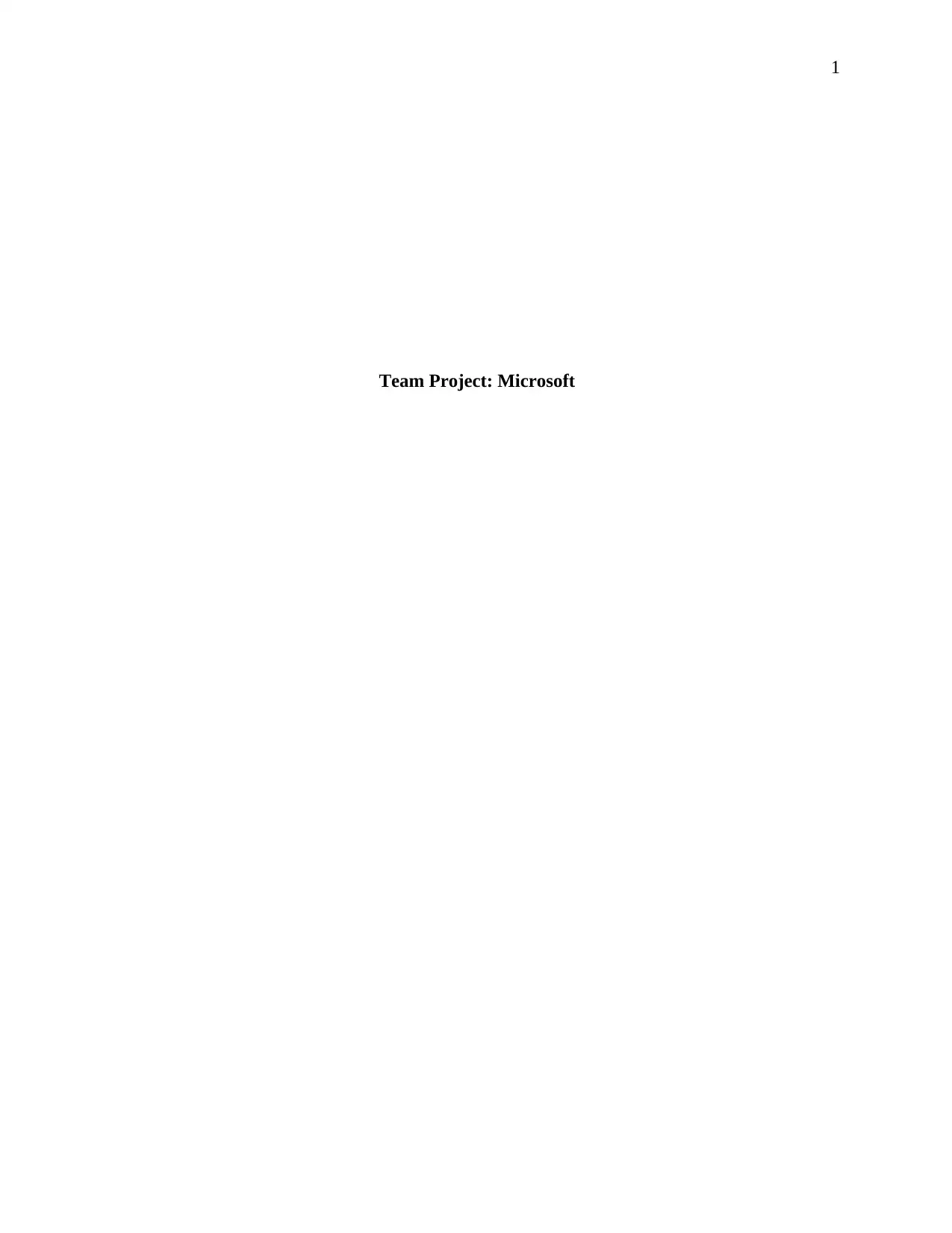
1
Team Project: Microsoft
Team Project: Microsoft
Paraphrase This Document
Need a fresh take? Get an instant paraphrase of this document with our AI Paraphraser
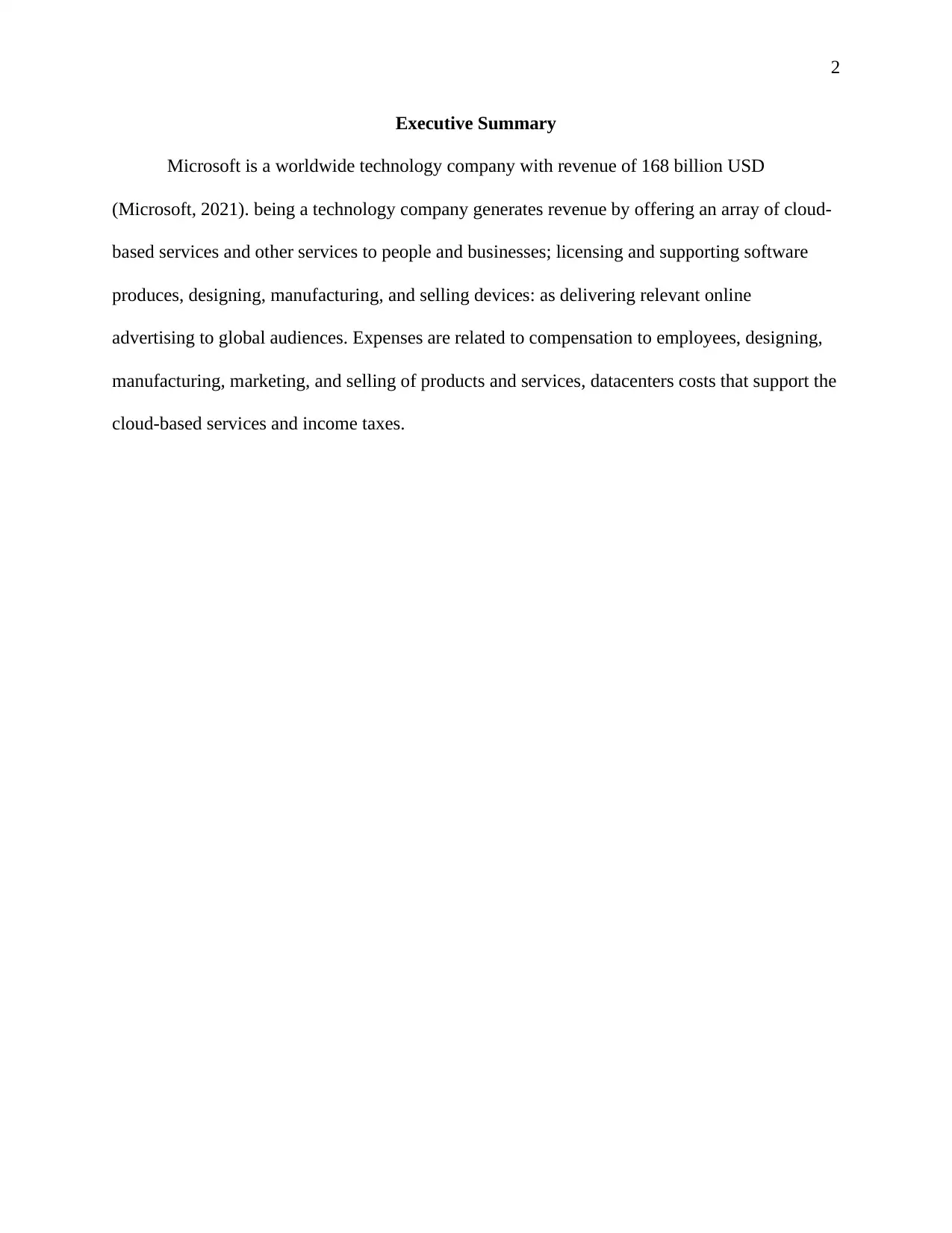
2
Executive Summary
Microsoft is a worldwide technology company with revenue of 168 billion USD
(Microsoft, 2021). being a technology company generates revenue by offering an array of cloud-
based services and other services to people and businesses; licensing and supporting software
produces, designing, manufacturing, and selling devices: as delivering relevant online
advertising to global audiences. Expenses are related to compensation to employees, designing,
manufacturing, marketing, and selling of products and services, datacenters costs that support the
cloud-based services and income taxes.
Executive Summary
Microsoft is a worldwide technology company with revenue of 168 billion USD
(Microsoft, 2021). being a technology company generates revenue by offering an array of cloud-
based services and other services to people and businesses; licensing and supporting software
produces, designing, manufacturing, and selling devices: as delivering relevant online
advertising to global audiences. Expenses are related to compensation to employees, designing,
manufacturing, marketing, and selling of products and services, datacenters costs that support the
cloud-based services and income taxes.
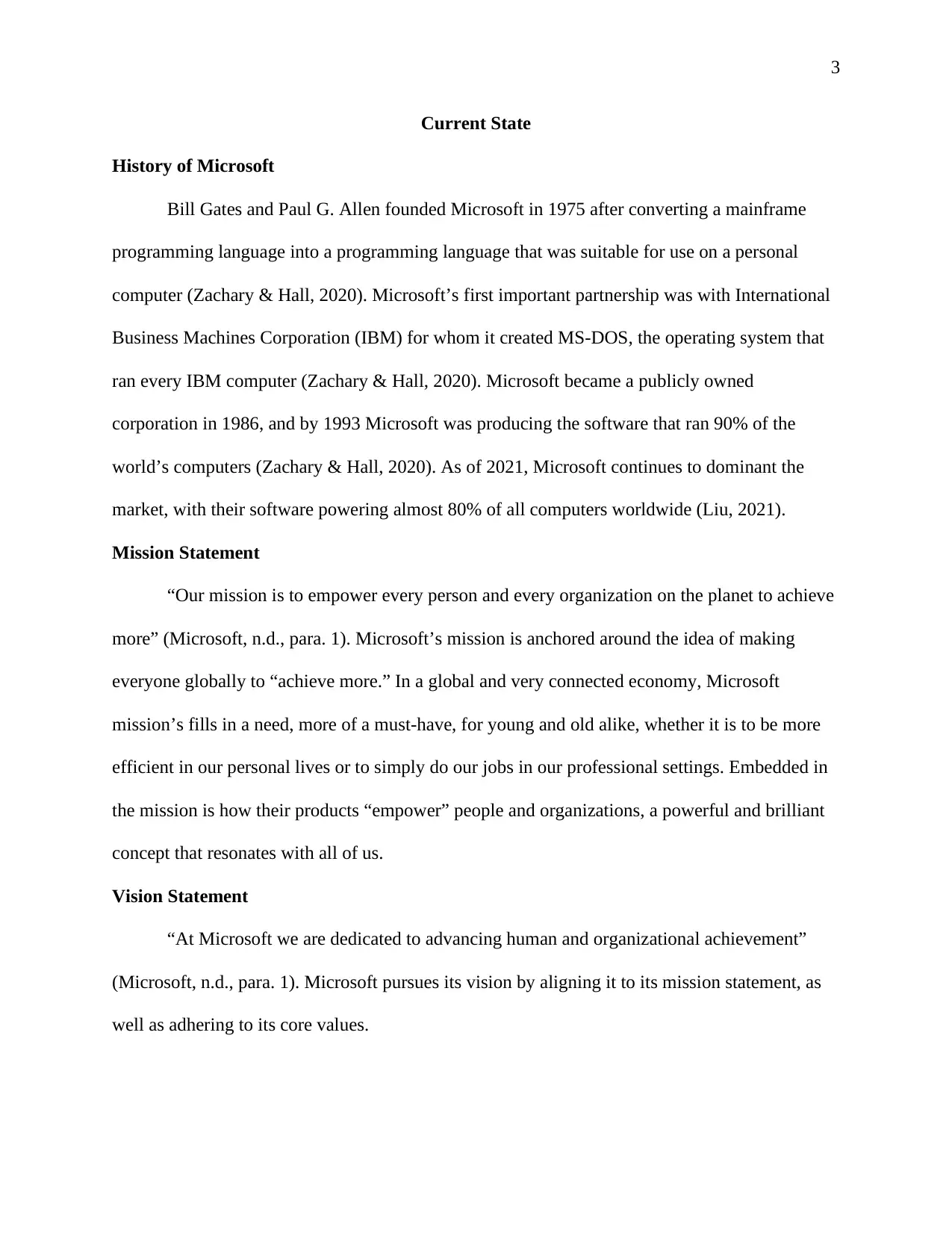
3
Current State
History of Microsoft
Bill Gates and Paul G. Allen founded Microsoft in 1975 after converting a mainframe
programming language into a programming language that was suitable for use on a personal
computer (Zachary & Hall, 2020). Microsoft’s first important partnership was with International
Business Machines Corporation (IBM) for whom it created MS-DOS, the operating system that
ran every IBM computer (Zachary & Hall, 2020). Microsoft became a publicly owned
corporation in 1986, and by 1993 Microsoft was producing the software that ran 90% of the
world’s computers (Zachary & Hall, 2020). As of 2021, Microsoft continues to dominant the
market, with their software powering almost 80% of all computers worldwide (Liu, 2021).
Mission Statement
“Our mission is to empower every person and every organization on the planet to achieve
more” (Microsoft, n.d., para. 1). Microsoft’s mission is anchored around the idea of making
everyone globally to “achieve more.” In a global and very connected economy, Microsoft
mission’s fills in a need, more of a must-have, for young and old alike, whether it is to be more
efficient in our personal lives or to simply do our jobs in our professional settings. Embedded in
the mission is how their products “empower” people and organizations, a powerful and brilliant
concept that resonates with all of us.
Vision Statement
“At Microsoft we are dedicated to advancing human and organizational achievement”
(Microsoft, n.d., para. 1). Microsoft pursues its vision by aligning it to its mission statement, as
well as adhering to its core values.
Current State
History of Microsoft
Bill Gates and Paul G. Allen founded Microsoft in 1975 after converting a mainframe
programming language into a programming language that was suitable for use on a personal
computer (Zachary & Hall, 2020). Microsoft’s first important partnership was with International
Business Machines Corporation (IBM) for whom it created MS-DOS, the operating system that
ran every IBM computer (Zachary & Hall, 2020). Microsoft became a publicly owned
corporation in 1986, and by 1993 Microsoft was producing the software that ran 90% of the
world’s computers (Zachary & Hall, 2020). As of 2021, Microsoft continues to dominant the
market, with their software powering almost 80% of all computers worldwide (Liu, 2021).
Mission Statement
“Our mission is to empower every person and every organization on the planet to achieve
more” (Microsoft, n.d., para. 1). Microsoft’s mission is anchored around the idea of making
everyone globally to “achieve more.” In a global and very connected economy, Microsoft
mission’s fills in a need, more of a must-have, for young and old alike, whether it is to be more
efficient in our personal lives or to simply do our jobs in our professional settings. Embedded in
the mission is how their products “empower” people and organizations, a powerful and brilliant
concept that resonates with all of us.
Vision Statement
“At Microsoft we are dedicated to advancing human and organizational achievement”
(Microsoft, n.d., para. 1). Microsoft pursues its vision by aligning it to its mission statement, as
well as adhering to its core values.
⊘ This is a preview!⊘
Do you want full access?
Subscribe today to unlock all pages.

Trusted by 1+ million students worldwide
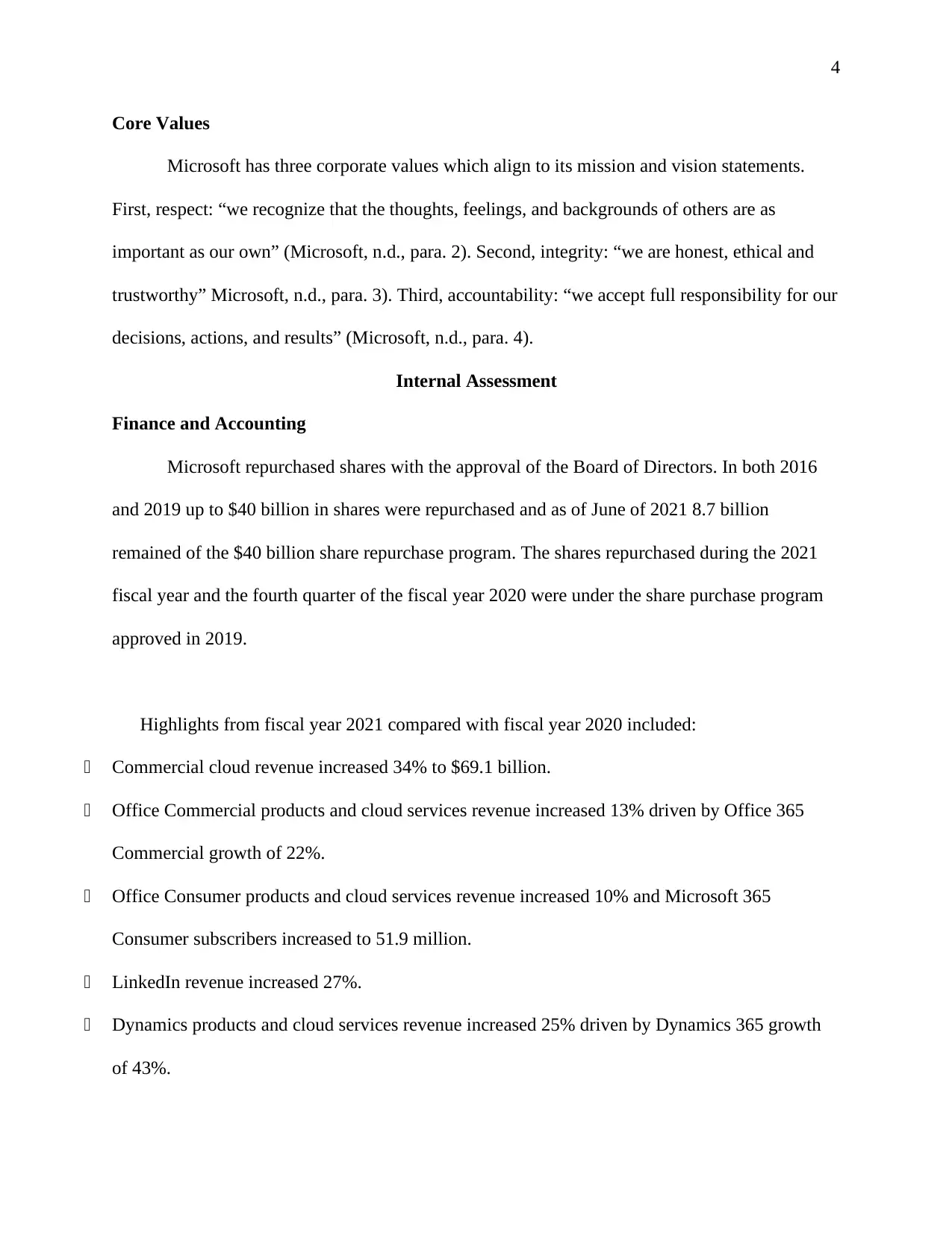
4
Core Values
Microsoft has three corporate values which align to its mission and vision statements.
First, respect: “we recognize that the thoughts, feelings, and backgrounds of others are as
important as our own” (Microsoft, n.d., para. 2). Second, integrity: “we are honest, ethical and
trustworthy” Microsoft, n.d., para. 3). Third, accountability: “we accept full responsibility for our
decisions, actions, and results” (Microsoft, n.d., para. 4).
Internal Assessment
Finance and Accounting
Microsoft repurchased shares with the approval of the Board of Directors. In both 2016
and 2019 up to $40 billion in shares were repurchased and as of June of 2021 8.7 billion
remained of the $40 billion share repurchase program. The shares repurchased during the 2021
fiscal year and the fourth quarter of the fiscal year 2020 were under the share purchase program
approved in 2019.
Highlights from fiscal year 2021 compared with fiscal year 2020 included:
Commercial cloud revenue increased 34% to $69.1 billion.
Office Commercial products and cloud services revenue increased 13% driven by Office 365
Commercial growth of 22%.
Office Consumer products and cloud services revenue increased 10% and Microsoft 365
Consumer subscribers increased to 51.9 million.
LinkedIn revenue increased 27%.
Dynamics products and cloud services revenue increased 25% driven by Dynamics 365 growth
of 43%.
Core Values
Microsoft has three corporate values which align to its mission and vision statements.
First, respect: “we recognize that the thoughts, feelings, and backgrounds of others are as
important as our own” (Microsoft, n.d., para. 2). Second, integrity: “we are honest, ethical and
trustworthy” Microsoft, n.d., para. 3). Third, accountability: “we accept full responsibility for our
decisions, actions, and results” (Microsoft, n.d., para. 4).
Internal Assessment
Finance and Accounting
Microsoft repurchased shares with the approval of the Board of Directors. In both 2016
and 2019 up to $40 billion in shares were repurchased and as of June of 2021 8.7 billion
remained of the $40 billion share repurchase program. The shares repurchased during the 2021
fiscal year and the fourth quarter of the fiscal year 2020 were under the share purchase program
approved in 2019.
Highlights from fiscal year 2021 compared with fiscal year 2020 included:
Commercial cloud revenue increased 34% to $69.1 billion.
Office Commercial products and cloud services revenue increased 13% driven by Office 365
Commercial growth of 22%.
Office Consumer products and cloud services revenue increased 10% and Microsoft 365
Consumer subscribers increased to 51.9 million.
LinkedIn revenue increased 27%.
Dynamics products and cloud services revenue increased 25% driven by Dynamics 365 growth
of 43%.
Paraphrase This Document
Need a fresh take? Get an instant paraphrase of this document with our AI Paraphraser
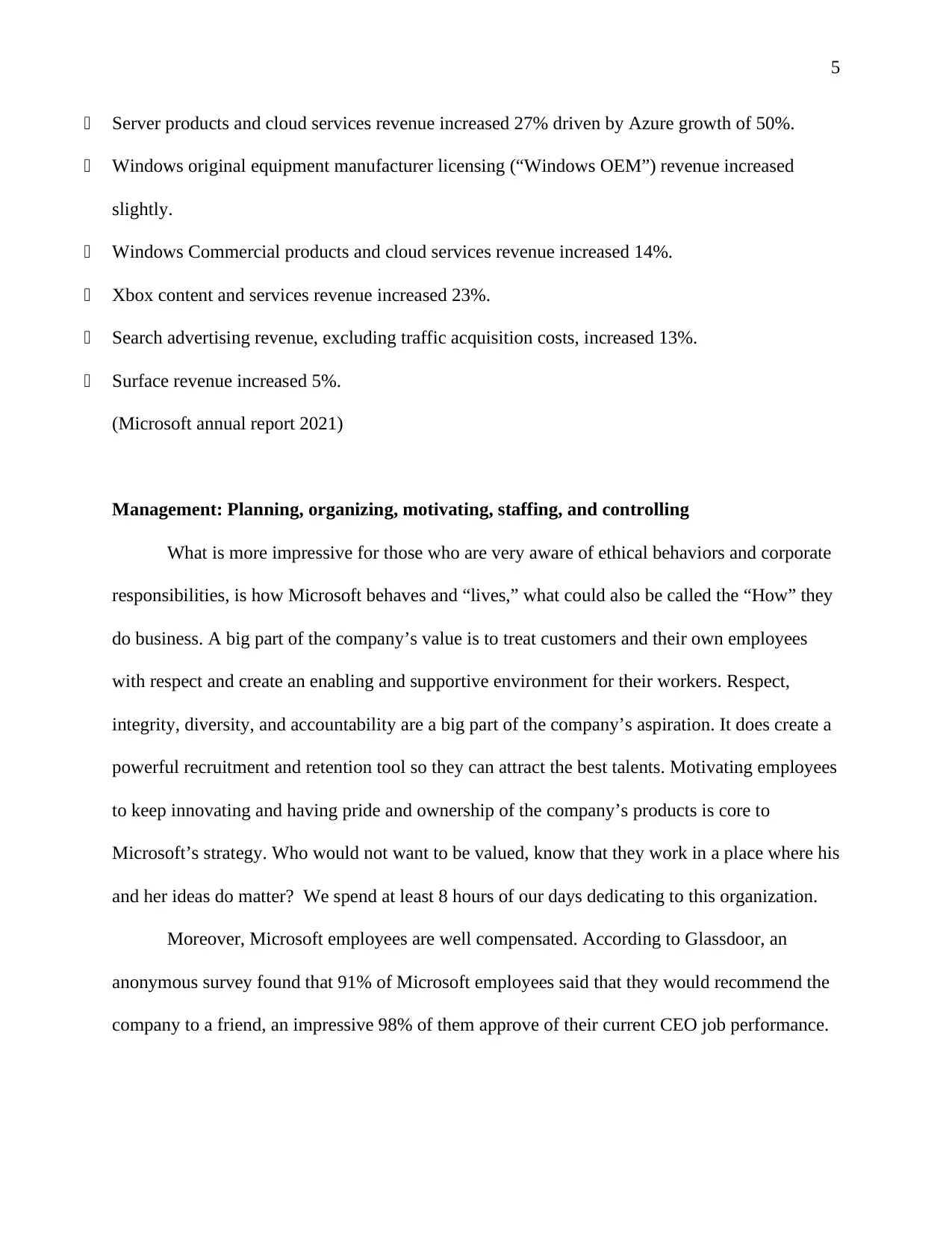
5
Server products and cloud services revenue increased 27% driven by Azure growth of 50%.
Windows original equipment manufacturer licensing (“Windows OEM”) revenue increased
slightly.
Windows Commercial products and cloud services revenue increased 14%.
Xbox content and services revenue increased 23%.
Search advertising revenue, excluding traffic acquisition costs, increased 13%.
Surface revenue increased 5%.
(Microsoft annual report 2021)
Management: Planning, organizing, motivating, staffing, and controlling
What is more impressive for those who are very aware of ethical behaviors and corporate
responsibilities, is how Microsoft behaves and “lives,” what could also be called the “How” they
do business. A big part of the company’s value is to treat customers and their own employees
with respect and create an enabling and supportive environment for their workers. Respect,
integrity, diversity, and accountability are a big part of the company’s aspiration. It does create a
powerful recruitment and retention tool so they can attract the best talents. Motivating employees
to keep innovating and having pride and ownership of the company’s products is core to
Microsoft’s strategy. Who would not want to be valued, know that they work in a place where his
and her ideas do matter? We spend at least 8 hours of our days dedicating to this organization.
Moreover, Microsoft employees are well compensated. According to Glassdoor, an
anonymous survey found that 91% of Microsoft employees said that they would recommend the
company to a friend, an impressive 98% of them approve of their current CEO job performance.
Server products and cloud services revenue increased 27% driven by Azure growth of 50%.
Windows original equipment manufacturer licensing (“Windows OEM”) revenue increased
slightly.
Windows Commercial products and cloud services revenue increased 14%.
Xbox content and services revenue increased 23%.
Search advertising revenue, excluding traffic acquisition costs, increased 13%.
Surface revenue increased 5%.
(Microsoft annual report 2021)
Management: Planning, organizing, motivating, staffing, and controlling
What is more impressive for those who are very aware of ethical behaviors and corporate
responsibilities, is how Microsoft behaves and “lives,” what could also be called the “How” they
do business. A big part of the company’s value is to treat customers and their own employees
with respect and create an enabling and supportive environment for their workers. Respect,
integrity, diversity, and accountability are a big part of the company’s aspiration. It does create a
powerful recruitment and retention tool so they can attract the best talents. Motivating employees
to keep innovating and having pride and ownership of the company’s products is core to
Microsoft’s strategy. Who would not want to be valued, know that they work in a place where his
and her ideas do matter? We spend at least 8 hours of our days dedicating to this organization.
Moreover, Microsoft employees are well compensated. According to Glassdoor, an
anonymous survey found that 91% of Microsoft employees said that they would recommend the
company to a friend, an impressive 98% of them approve of their current CEO job performance.
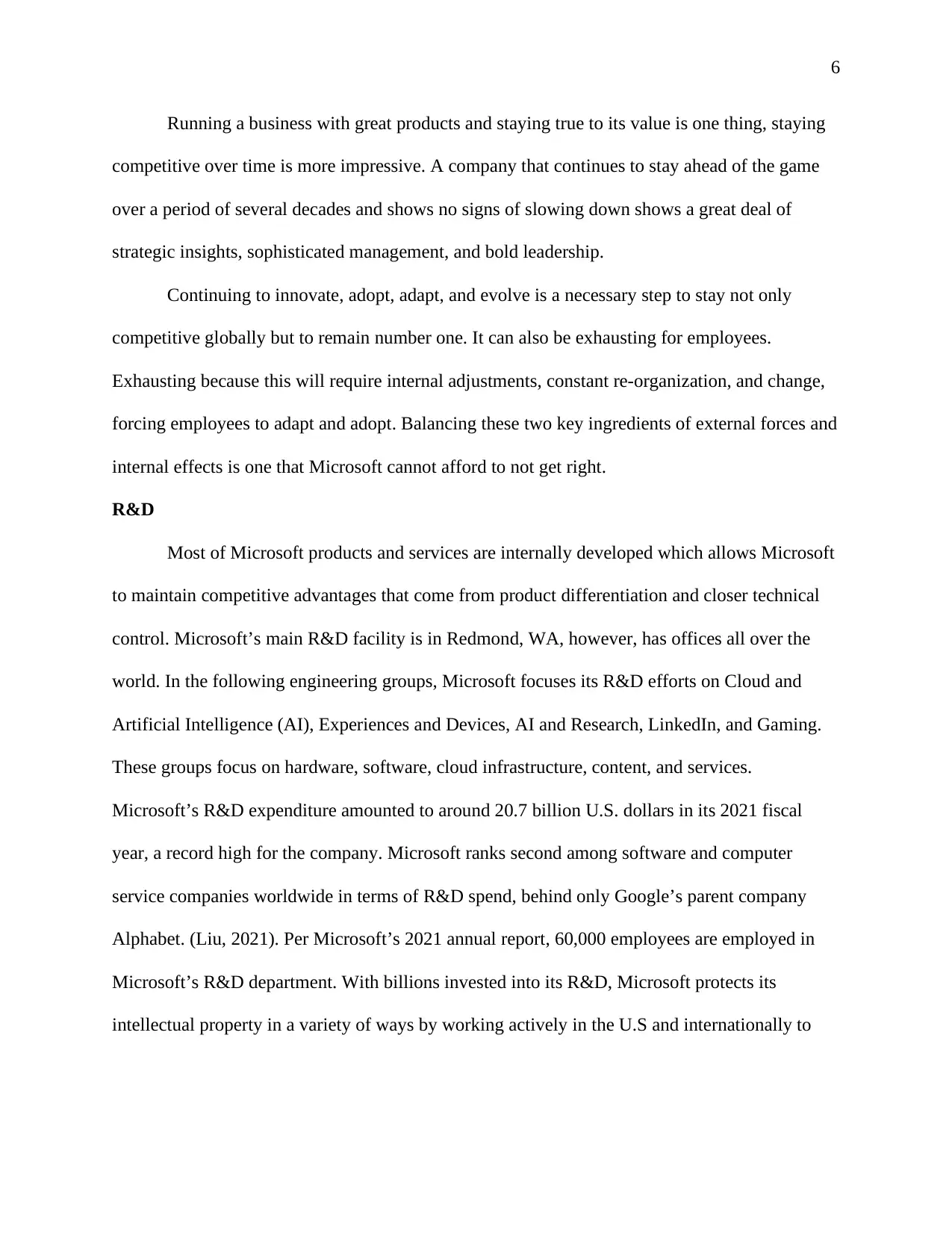
6
Running a business with great products and staying true to its value is one thing, staying
competitive over time is more impressive. A company that continues to stay ahead of the game
over a period of several decades and shows no signs of slowing down shows a great deal of
strategic insights, sophisticated management, and bold leadership.
Continuing to innovate, adopt, adapt, and evolve is a necessary step to stay not only
competitive globally but to remain number one. It can also be exhausting for employees.
Exhausting because this will require internal adjustments, constant re-organization, and change,
forcing employees to adapt and adopt. Balancing these two key ingredients of external forces and
internal effects is one that Microsoft cannot afford to not get right.
R&D
Most of Microsoft products and services are internally developed which allows Microsoft
to maintain competitive advantages that come from product differentiation and closer technical
control. Microsoft’s main R&D facility is in Redmond, WA, however, has offices all over the
world. In the following engineering groups, Microsoft focuses its R&D efforts on Cloud and
Artificial Intelligence (AI), Experiences and Devices, AI and Research, LinkedIn, and Gaming.
These groups focus on hardware, software, cloud infrastructure, content, and services.
Microsoft’s R&D expenditure amounted to around 20.7 billion U.S. dollars in its 2021 fiscal
year, a record high for the company. Microsoft ranks second among software and computer
service companies worldwide in terms of R&D spend, behind only Google’s parent company
Alphabet. (Liu, 2021). Per Microsoft’s 2021 annual report, 60,000 employees are employed in
Microsoft’s R&D department. With billions invested into its R&D, Microsoft protects its
intellectual property in a variety of ways by working actively in the U.S and internationally to
Running a business with great products and staying true to its value is one thing, staying
competitive over time is more impressive. A company that continues to stay ahead of the game
over a period of several decades and shows no signs of slowing down shows a great deal of
strategic insights, sophisticated management, and bold leadership.
Continuing to innovate, adopt, adapt, and evolve is a necessary step to stay not only
competitive globally but to remain number one. It can also be exhausting for employees.
Exhausting because this will require internal adjustments, constant re-organization, and change,
forcing employees to adapt and adopt. Balancing these two key ingredients of external forces and
internal effects is one that Microsoft cannot afford to not get right.
R&D
Most of Microsoft products and services are internally developed which allows Microsoft
to maintain competitive advantages that come from product differentiation and closer technical
control. Microsoft’s main R&D facility is in Redmond, WA, however, has offices all over the
world. In the following engineering groups, Microsoft focuses its R&D efforts on Cloud and
Artificial Intelligence (AI), Experiences and Devices, AI and Research, LinkedIn, and Gaming.
These groups focus on hardware, software, cloud infrastructure, content, and services.
Microsoft’s R&D expenditure amounted to around 20.7 billion U.S. dollars in its 2021 fiscal
year, a record high for the company. Microsoft ranks second among software and computer
service companies worldwide in terms of R&D spend, behind only Google’s parent company
Alphabet. (Liu, 2021). Per Microsoft’s 2021 annual report, 60,000 employees are employed in
Microsoft’s R&D department. With billions invested into its R&D, Microsoft protects its
intellectual property in a variety of ways by working actively in the U.S and internationally to
⊘ This is a preview!⊘
Do you want full access?
Subscribe today to unlock all pages.

Trusted by 1+ million students worldwide
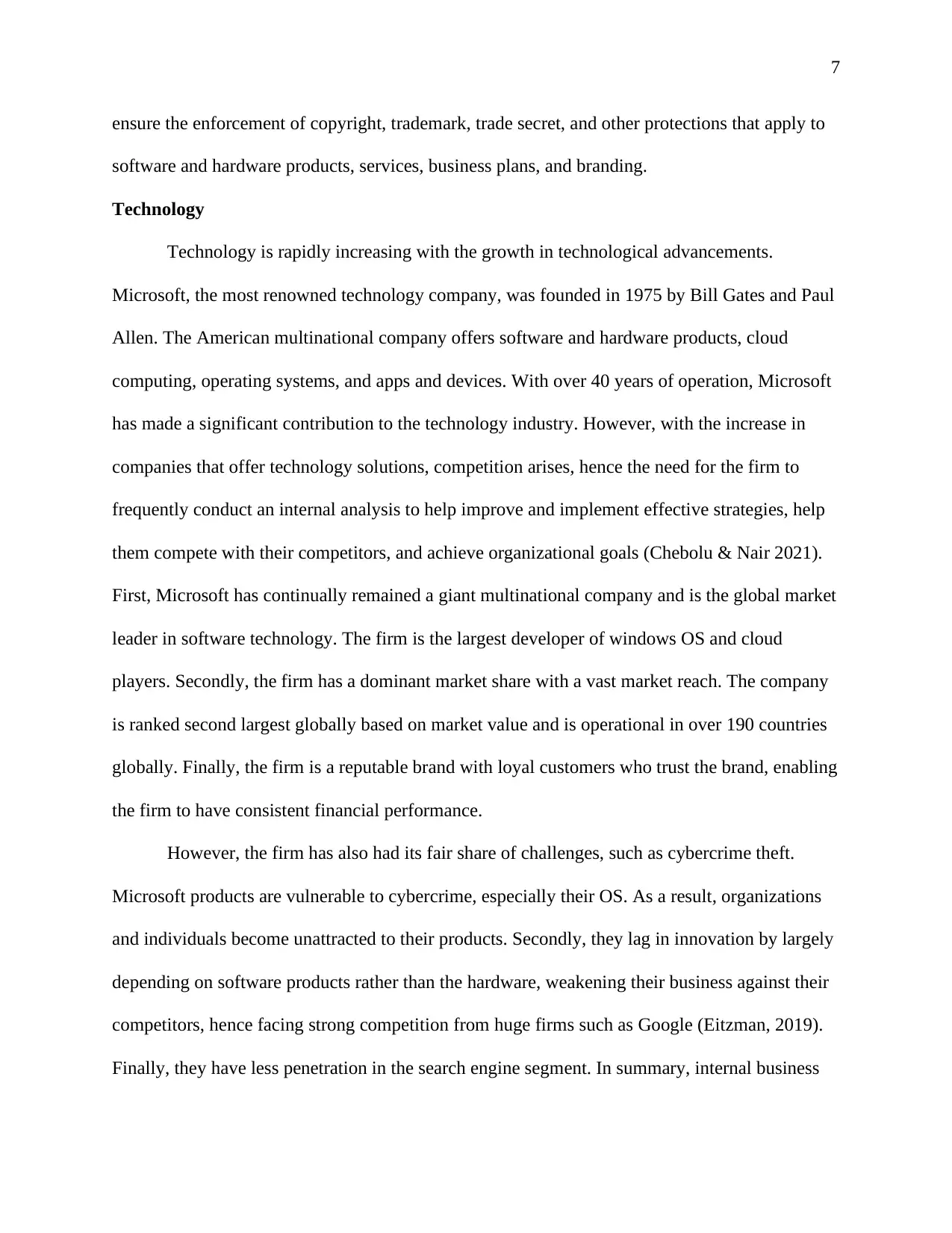
7
ensure the enforcement of copyright, trademark, trade secret, and other protections that apply to
software and hardware products, services, business plans, and branding.
Technology
Technology is rapidly increasing with the growth in technological advancements.
Microsoft, the most renowned technology company, was founded in 1975 by Bill Gates and Paul
Allen. The American multinational company offers software and hardware products, cloud
computing, operating systems, and apps and devices. With over 40 years of operation, Microsoft
has made a significant contribution to the technology industry. However, with the increase in
companies that offer technology solutions, competition arises, hence the need for the firm to
frequently conduct an internal analysis to help improve and implement effective strategies, help
them compete with their competitors, and achieve organizational goals (Chebolu & Nair 2021).
First, Microsoft has continually remained a giant multinational company and is the global market
leader in software technology. The firm is the largest developer of windows OS and cloud
players. Secondly, the firm has a dominant market share with a vast market reach. The company
is ranked second largest globally based on market value and is operational in over 190 countries
globally. Finally, the firm is a reputable brand with loyal customers who trust the brand, enabling
the firm to have consistent financial performance.
However, the firm has also had its fair share of challenges, such as cybercrime theft.
Microsoft products are vulnerable to cybercrime, especially their OS. As a result, organizations
and individuals become unattracted to their products. Secondly, they lag in innovation by largely
depending on software products rather than the hardware, weakening their business against their
competitors, hence facing strong competition from huge firms such as Google (Eitzman, 2019).
Finally, they have less penetration in the search engine segment. In summary, internal business
ensure the enforcement of copyright, trademark, trade secret, and other protections that apply to
software and hardware products, services, business plans, and branding.
Technology
Technology is rapidly increasing with the growth in technological advancements.
Microsoft, the most renowned technology company, was founded in 1975 by Bill Gates and Paul
Allen. The American multinational company offers software and hardware products, cloud
computing, operating systems, and apps and devices. With over 40 years of operation, Microsoft
has made a significant contribution to the technology industry. However, with the increase in
companies that offer technology solutions, competition arises, hence the need for the firm to
frequently conduct an internal analysis to help improve and implement effective strategies, help
them compete with their competitors, and achieve organizational goals (Chebolu & Nair 2021).
First, Microsoft has continually remained a giant multinational company and is the global market
leader in software technology. The firm is the largest developer of windows OS and cloud
players. Secondly, the firm has a dominant market share with a vast market reach. The company
is ranked second largest globally based on market value and is operational in over 190 countries
globally. Finally, the firm is a reputable brand with loyal customers who trust the brand, enabling
the firm to have consistent financial performance.
However, the firm has also had its fair share of challenges, such as cybercrime theft.
Microsoft products are vulnerable to cybercrime, especially their OS. As a result, organizations
and individuals become unattracted to their products. Secondly, they lag in innovation by largely
depending on software products rather than the hardware, weakening their business against their
competitors, hence facing strong competition from huge firms such as Google (Eitzman, 2019).
Finally, they have less penetration in the search engine segment. In summary, internal business
Paraphrase This Document
Need a fresh take? Get an instant paraphrase of this document with our AI Paraphraser
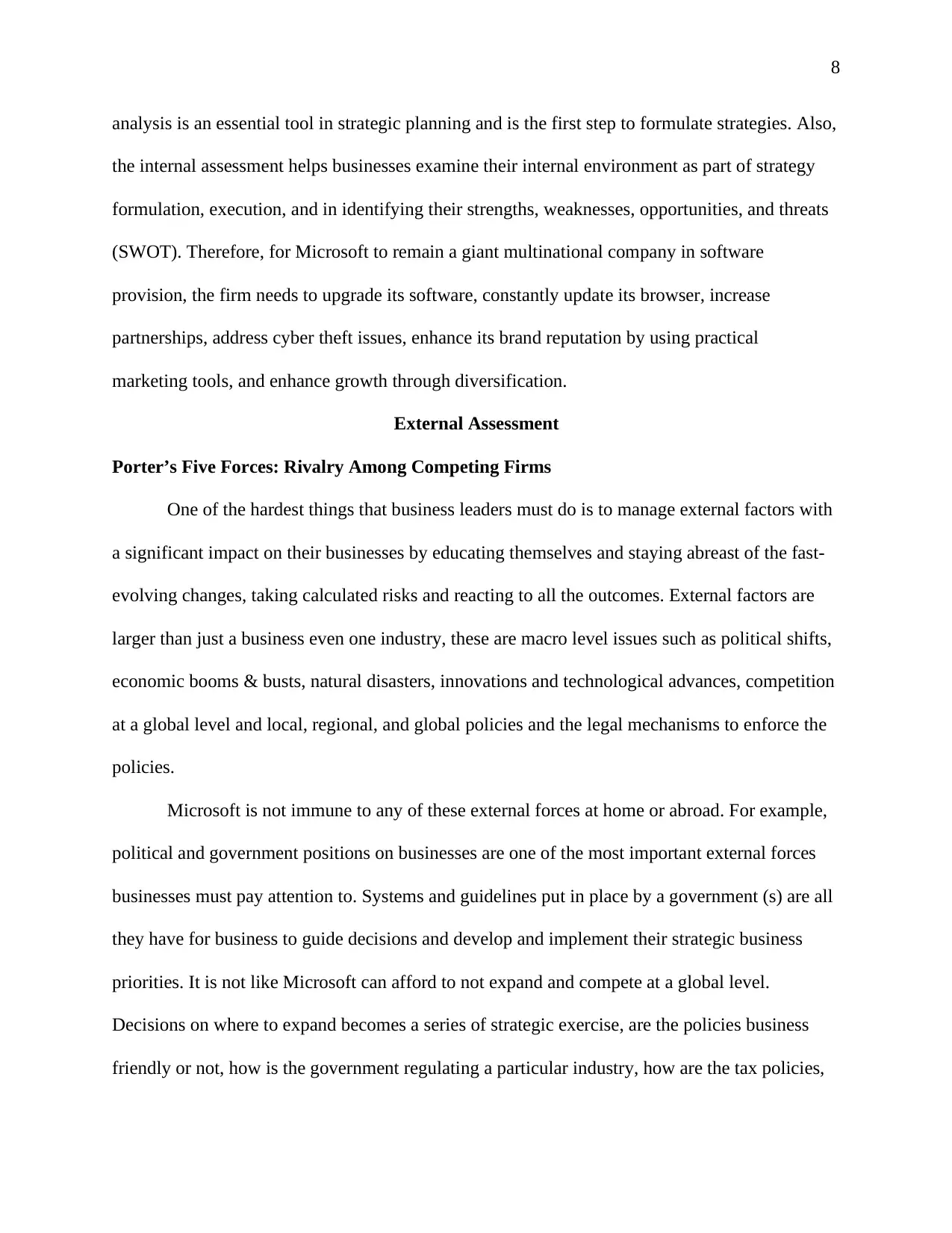
8
analysis is an essential tool in strategic planning and is the first step to formulate strategies. Also,
the internal assessment helps businesses examine their internal environment as part of strategy
formulation, execution, and in identifying their strengths, weaknesses, opportunities, and threats
(SWOT). Therefore, for Microsoft to remain a giant multinational company in software
provision, the firm needs to upgrade its software, constantly update its browser, increase
partnerships, address cyber theft issues, enhance its brand reputation by using practical
marketing tools, and enhance growth through diversification.
External Assessment
Porter’s Five Forces: Rivalry Among Competing Firms
One of the hardest things that business leaders must do is to manage external factors with
a significant impact on their businesses by educating themselves and staying abreast of the fast-
evolving changes, taking calculated risks and reacting to all the outcomes. External factors are
larger than just a business even one industry, these are macro level issues such as political shifts,
economic booms & busts, natural disasters, innovations and technological advances, competition
at a global level and local, regional, and global policies and the legal mechanisms to enforce the
policies.
Microsoft is not immune to any of these external forces at home or abroad. For example,
political and government positions on businesses are one of the most important external forces
businesses must pay attention to. Systems and guidelines put in place by a government (s) are all
they have for business to guide decisions and develop and implement their strategic business
priorities. It is not like Microsoft can afford to not expand and compete at a global level.
Decisions on where to expand becomes a series of strategic exercise, are the policies business
friendly or not, how is the government regulating a particular industry, how are the tax policies,
analysis is an essential tool in strategic planning and is the first step to formulate strategies. Also,
the internal assessment helps businesses examine their internal environment as part of strategy
formulation, execution, and in identifying their strengths, weaknesses, opportunities, and threats
(SWOT). Therefore, for Microsoft to remain a giant multinational company in software
provision, the firm needs to upgrade its software, constantly update its browser, increase
partnerships, address cyber theft issues, enhance its brand reputation by using practical
marketing tools, and enhance growth through diversification.
External Assessment
Porter’s Five Forces: Rivalry Among Competing Firms
One of the hardest things that business leaders must do is to manage external factors with
a significant impact on their businesses by educating themselves and staying abreast of the fast-
evolving changes, taking calculated risks and reacting to all the outcomes. External factors are
larger than just a business even one industry, these are macro level issues such as political shifts,
economic booms & busts, natural disasters, innovations and technological advances, competition
at a global level and local, regional, and global policies and the legal mechanisms to enforce the
policies.
Microsoft is not immune to any of these external forces at home or abroad. For example,
political and government positions on businesses are one of the most important external forces
businesses must pay attention to. Systems and guidelines put in place by a government (s) are all
they have for business to guide decisions and develop and implement their strategic business
priorities. It is not like Microsoft can afford to not expand and compete at a global level.
Decisions on where to expand becomes a series of strategic exercise, are the policies business
friendly or not, how is the government regulating a particular industry, how are the tax policies,
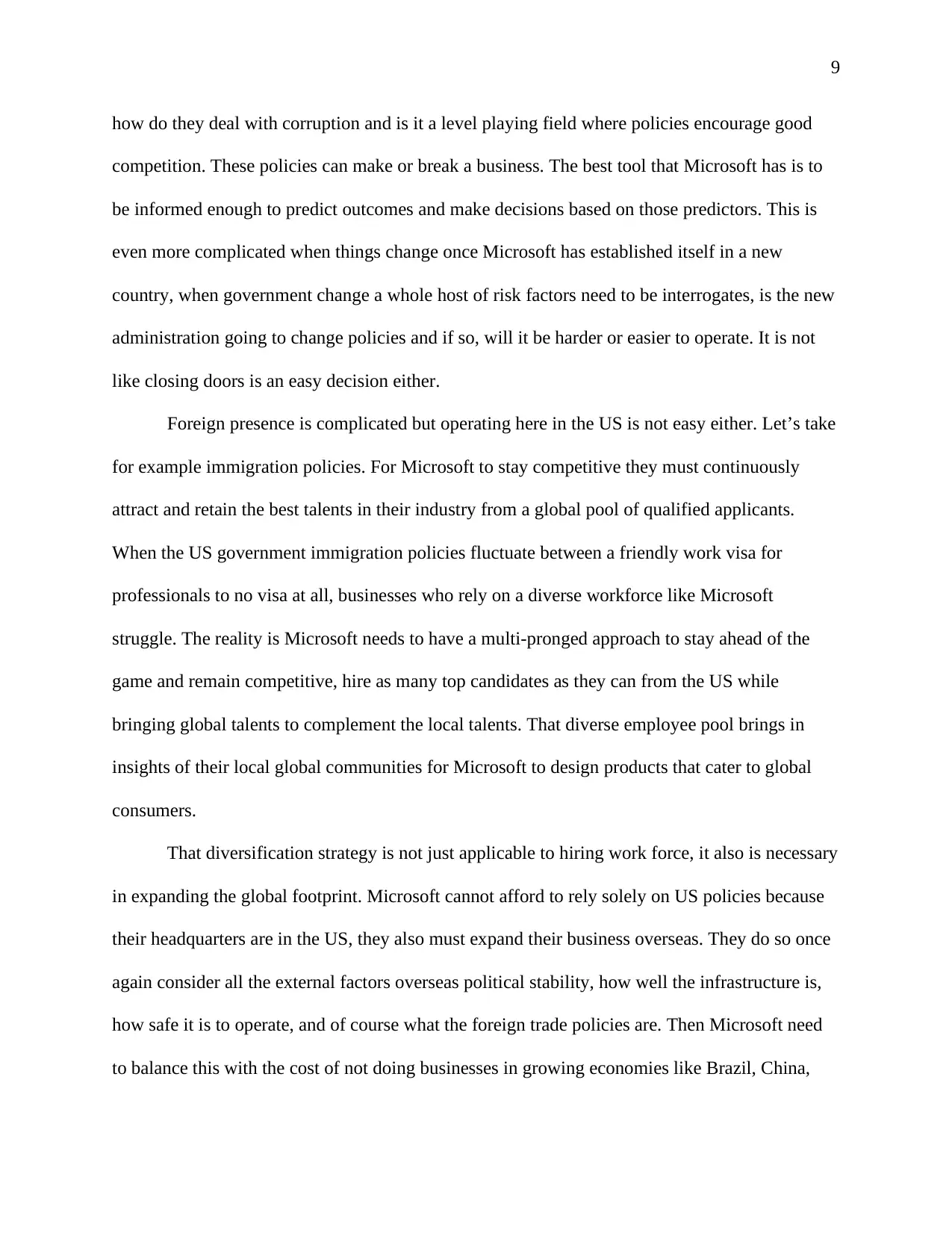
9
how do they deal with corruption and is it a level playing field where policies encourage good
competition. These policies can make or break a business. The best tool that Microsoft has is to
be informed enough to predict outcomes and make decisions based on those predictors. This is
even more complicated when things change once Microsoft has established itself in a new
country, when government change a whole host of risk factors need to be interrogates, is the new
administration going to change policies and if so, will it be harder or easier to operate. It is not
like closing doors is an easy decision either.
Foreign presence is complicated but operating here in the US is not easy either. Let’s take
for example immigration policies. For Microsoft to stay competitive they must continuously
attract and retain the best talents in their industry from a global pool of qualified applicants.
When the US government immigration policies fluctuate between a friendly work visa for
professionals to no visa at all, businesses who rely on a diverse workforce like Microsoft
struggle. The reality is Microsoft needs to have a multi-pronged approach to stay ahead of the
game and remain competitive, hire as many top candidates as they can from the US while
bringing global talents to complement the local talents. That diverse employee pool brings in
insights of their local global communities for Microsoft to design products that cater to global
consumers.
That diversification strategy is not just applicable to hiring work force, it also is necessary
in expanding the global footprint. Microsoft cannot afford to rely solely on US policies because
their headquarters are in the US, they also must expand their business overseas. They do so once
again consider all the external factors overseas political stability, how well the infrastructure is,
how safe it is to operate, and of course what the foreign trade policies are. Then Microsoft need
to balance this with the cost of not doing businesses in growing economies like Brazil, China,
how do they deal with corruption and is it a level playing field where policies encourage good
competition. These policies can make or break a business. The best tool that Microsoft has is to
be informed enough to predict outcomes and make decisions based on those predictors. This is
even more complicated when things change once Microsoft has established itself in a new
country, when government change a whole host of risk factors need to be interrogates, is the new
administration going to change policies and if so, will it be harder or easier to operate. It is not
like closing doors is an easy decision either.
Foreign presence is complicated but operating here in the US is not easy either. Let’s take
for example immigration policies. For Microsoft to stay competitive they must continuously
attract and retain the best talents in their industry from a global pool of qualified applicants.
When the US government immigration policies fluctuate between a friendly work visa for
professionals to no visa at all, businesses who rely on a diverse workforce like Microsoft
struggle. The reality is Microsoft needs to have a multi-pronged approach to stay ahead of the
game and remain competitive, hire as many top candidates as they can from the US while
bringing global talents to complement the local talents. That diverse employee pool brings in
insights of their local global communities for Microsoft to design products that cater to global
consumers.
That diversification strategy is not just applicable to hiring work force, it also is necessary
in expanding the global footprint. Microsoft cannot afford to rely solely on US policies because
their headquarters are in the US, they also must expand their business overseas. They do so once
again consider all the external factors overseas political stability, how well the infrastructure is,
how safe it is to operate, and of course what the foreign trade policies are. Then Microsoft need
to balance this with the cost of not doing businesses in growing economies like Brazil, China,
⊘ This is a preview!⊘
Do you want full access?
Subscribe today to unlock all pages.

Trusted by 1+ million students worldwide
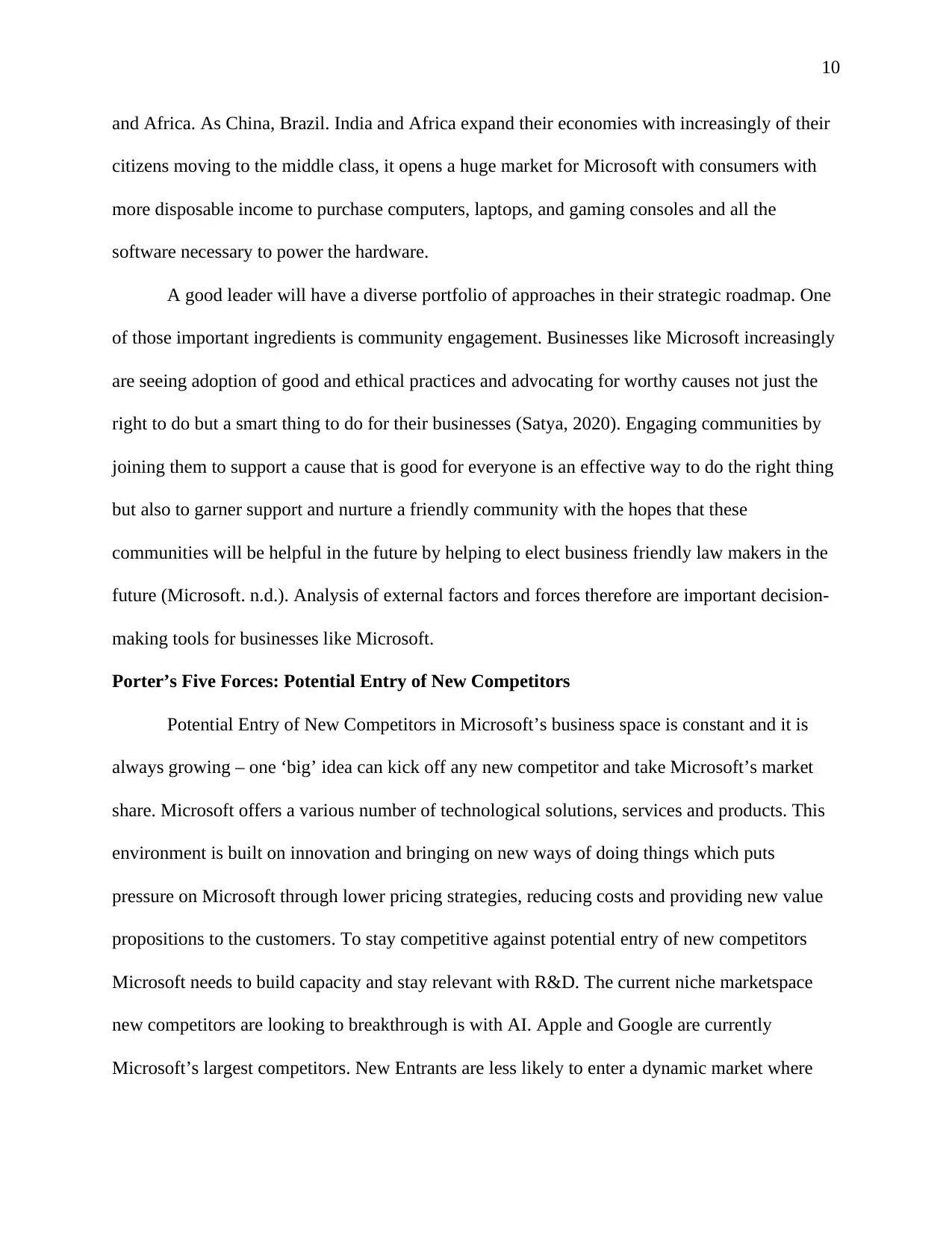
10
and Africa. As China, Brazil. India and Africa expand their economies with increasingly of their
citizens moving to the middle class, it opens a huge market for Microsoft with consumers with
more disposable income to purchase computers, laptops, and gaming consoles and all the
software necessary to power the hardware.
A good leader will have a diverse portfolio of approaches in their strategic roadmap. One
of those important ingredients is community engagement. Businesses like Microsoft increasingly
are seeing adoption of good and ethical practices and advocating for worthy causes not just the
right to do but a smart thing to do for their businesses (Satya, 2020). Engaging communities by
joining them to support a cause that is good for everyone is an effective way to do the right thing
but also to garner support and nurture a friendly community with the hopes that these
communities will be helpful in the future by helping to elect business friendly law makers in the
future (Microsoft. n.d.). Analysis of external factors and forces therefore are important decision-
making tools for businesses like Microsoft.
Porter’s Five Forces: Potential Entry of New Competitors
Potential Entry of New Competitors in Microsoft’s business space is constant and it is
always growing – one ‘big’ idea can kick off any new competitor and take Microsoft’s market
share. Microsoft offers a various number of technological solutions, services and products. This
environment is built on innovation and bringing on new ways of doing things which puts
pressure on Microsoft through lower pricing strategies, reducing costs and providing new value
propositions to the customers. To stay competitive against potential entry of new competitors
Microsoft needs to build capacity and stay relevant with R&D. The current niche marketspace
new competitors are looking to breakthrough is with AI. Apple and Google are currently
Microsoft’s largest competitors. New Entrants are less likely to enter a dynamic market where
and Africa. As China, Brazil. India and Africa expand their economies with increasingly of their
citizens moving to the middle class, it opens a huge market for Microsoft with consumers with
more disposable income to purchase computers, laptops, and gaming consoles and all the
software necessary to power the hardware.
A good leader will have a diverse portfolio of approaches in their strategic roadmap. One
of those important ingredients is community engagement. Businesses like Microsoft increasingly
are seeing adoption of good and ethical practices and advocating for worthy causes not just the
right to do but a smart thing to do for their businesses (Satya, 2020). Engaging communities by
joining them to support a cause that is good for everyone is an effective way to do the right thing
but also to garner support and nurture a friendly community with the hopes that these
communities will be helpful in the future by helping to elect business friendly law makers in the
future (Microsoft. n.d.). Analysis of external factors and forces therefore are important decision-
making tools for businesses like Microsoft.
Porter’s Five Forces: Potential Entry of New Competitors
Potential Entry of New Competitors in Microsoft’s business space is constant and it is
always growing – one ‘big’ idea can kick off any new competitor and take Microsoft’s market
share. Microsoft offers a various number of technological solutions, services and products. This
environment is built on innovation and bringing on new ways of doing things which puts
pressure on Microsoft through lower pricing strategies, reducing costs and providing new value
propositions to the customers. To stay competitive against potential entry of new competitors
Microsoft needs to build capacity and stay relevant with R&D. The current niche marketspace
new competitors are looking to breakthrough is with AI. Apple and Google are currently
Microsoft’s largest competitors. New Entrants are less likely to enter a dynamic market where
Paraphrase This Document
Need a fresh take? Get an instant paraphrase of this document with our AI Paraphraser
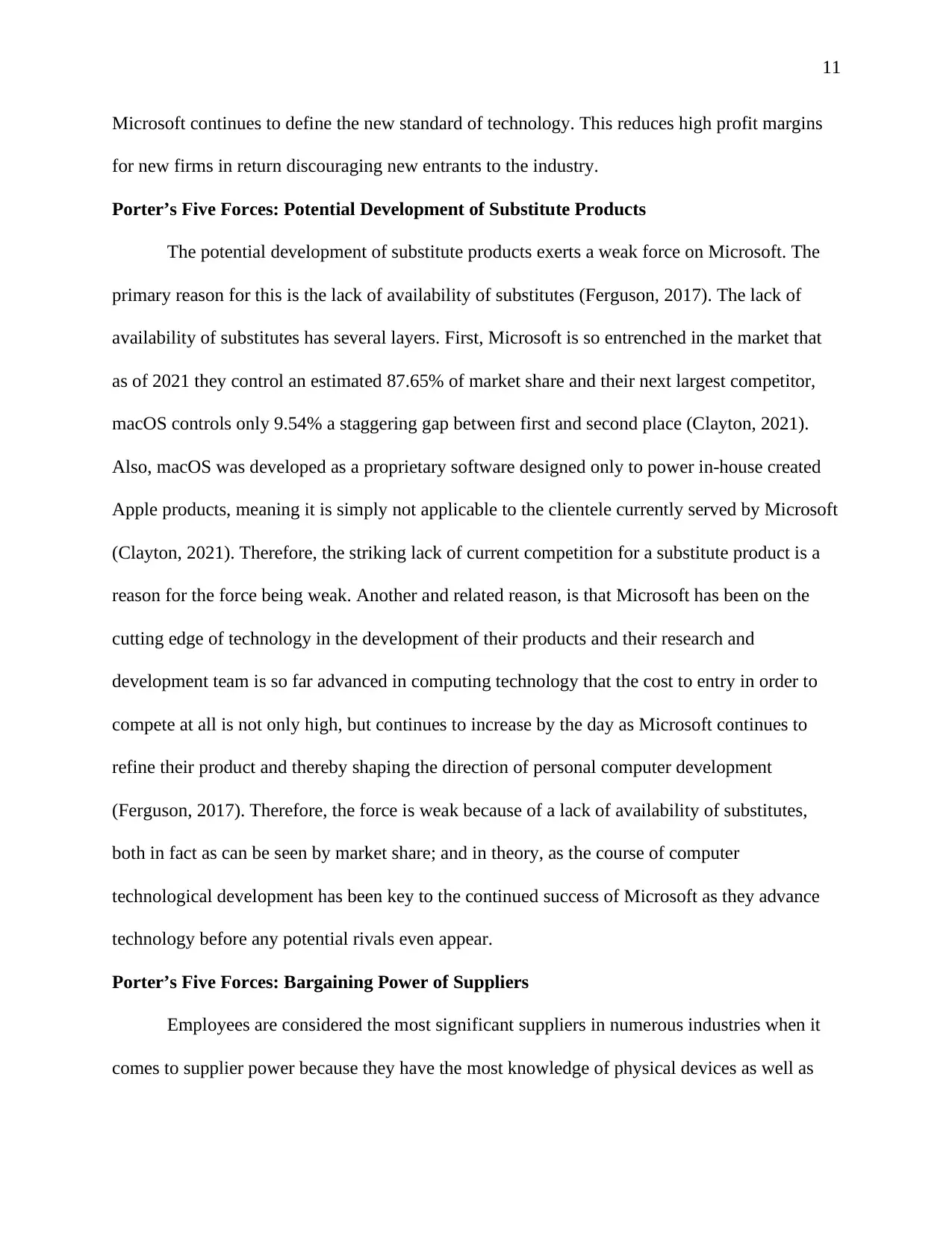
11
Microsoft continues to define the new standard of technology. This reduces high profit margins
for new firms in return discouraging new entrants to the industry.
Porter’s Five Forces: Potential Development of Substitute Products
The potential development of substitute products exerts a weak force on Microsoft. The
primary reason for this is the lack of availability of substitutes (Ferguson, 2017). The lack of
availability of substitutes has several layers. First, Microsoft is so entrenched in the market that
as of 2021 they control an estimated 87.65% of market share and their next largest competitor,
macOS controls only 9.54% a staggering gap between first and second place (Clayton, 2021).
Also, macOS was developed as a proprietary software designed only to power in-house created
Apple products, meaning it is simply not applicable to the clientele currently served by Microsoft
(Clayton, 2021). Therefore, the striking lack of current competition for a substitute product is a
reason for the force being weak. Another and related reason, is that Microsoft has been on the
cutting edge of technology in the development of their products and their research and
development team is so far advanced in computing technology that the cost to entry in order to
compete at all is not only high, but continues to increase by the day as Microsoft continues to
refine their product and thereby shaping the direction of personal computer development
(Ferguson, 2017). Therefore, the force is weak because of a lack of availability of substitutes,
both in fact as can be seen by market share; and in theory, as the course of computer
technological development has been key to the continued success of Microsoft as they advance
technology before any potential rivals even appear.
Porter’s Five Forces: Bargaining Power of Suppliers
Employees are considered the most significant suppliers in numerous industries when it
comes to supplier power because they have the most knowledge of physical devices as well as
Microsoft continues to define the new standard of technology. This reduces high profit margins
for new firms in return discouraging new entrants to the industry.
Porter’s Five Forces: Potential Development of Substitute Products
The potential development of substitute products exerts a weak force on Microsoft. The
primary reason for this is the lack of availability of substitutes (Ferguson, 2017). The lack of
availability of substitutes has several layers. First, Microsoft is so entrenched in the market that
as of 2021 they control an estimated 87.65% of market share and their next largest competitor,
macOS controls only 9.54% a staggering gap between first and second place (Clayton, 2021).
Also, macOS was developed as a proprietary software designed only to power in-house created
Apple products, meaning it is simply not applicable to the clientele currently served by Microsoft
(Clayton, 2021). Therefore, the striking lack of current competition for a substitute product is a
reason for the force being weak. Another and related reason, is that Microsoft has been on the
cutting edge of technology in the development of their products and their research and
development team is so far advanced in computing technology that the cost to entry in order to
compete at all is not only high, but continues to increase by the day as Microsoft continues to
refine their product and thereby shaping the direction of personal computer development
(Ferguson, 2017). Therefore, the force is weak because of a lack of availability of substitutes,
both in fact as can be seen by market share; and in theory, as the course of computer
technological development has been key to the continued success of Microsoft as they advance
technology before any potential rivals even appear.
Porter’s Five Forces: Bargaining Power of Suppliers
Employees are considered the most significant suppliers in numerous industries when it
comes to supplier power because they have the most knowledge of physical devices as well as
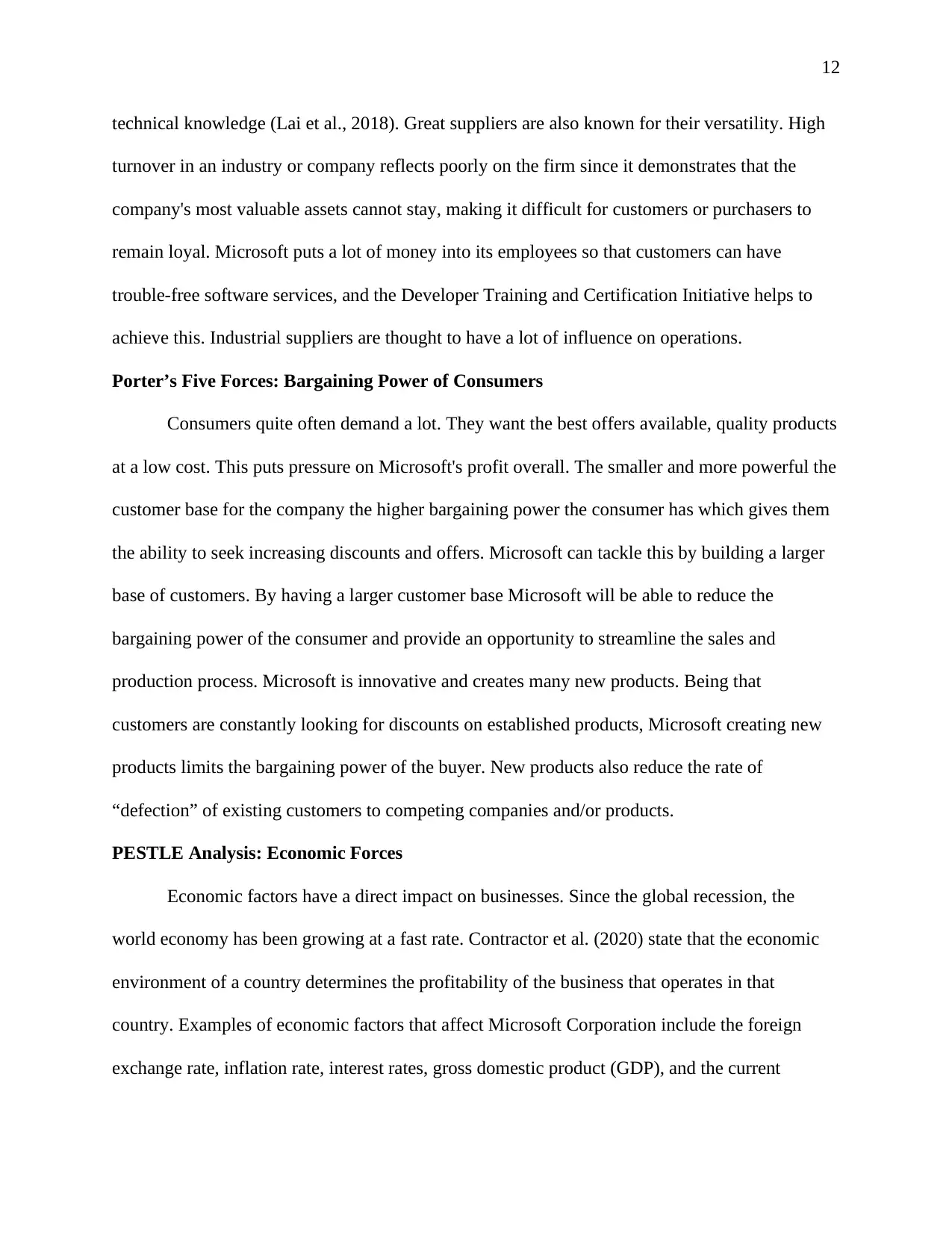
12
technical knowledge (Lai et al., 2018). Great suppliers are also known for their versatility. High
turnover in an industry or company reflects poorly on the firm since it demonstrates that the
company's most valuable assets cannot stay, making it difficult for customers or purchasers to
remain loyal. Microsoft puts a lot of money into its employees so that customers can have
trouble-free software services, and the Developer Training and Certification Initiative helps to
achieve this. Industrial suppliers are thought to have a lot of influence on operations.
Porter’s Five Forces: Bargaining Power of Consumers
Consumers quite often demand a lot. They want the best offers available, quality products
at a low cost. This puts pressure on Microsoft's profit overall. The smaller and more powerful the
customer base for the company the higher bargaining power the consumer has which gives them
the ability to seek increasing discounts and offers. Microsoft can tackle this by building a larger
base of customers. By having a larger customer base Microsoft will be able to reduce the
bargaining power of the consumer and provide an opportunity to streamline the sales and
production process. Microsoft is innovative and creates many new products. Being that
customers are constantly looking for discounts on established products, Microsoft creating new
products limits the bargaining power of the buyer. New products also reduce the rate of
“defection” of existing customers to competing companies and/or products.
PESTLE Analysis: Economic Forces
Economic factors have a direct impact on businesses. Since the global recession, the
world economy has been growing at a fast rate. Contractor et al. (2020) state that the economic
environment of a country determines the profitability of the business that operates in that
country. Examples of economic factors that affect Microsoft Corporation include the foreign
exchange rate, inflation rate, interest rates, gross domestic product (GDP), and the current
technical knowledge (Lai et al., 2018). Great suppliers are also known for their versatility. High
turnover in an industry or company reflects poorly on the firm since it demonstrates that the
company's most valuable assets cannot stay, making it difficult for customers or purchasers to
remain loyal. Microsoft puts a lot of money into its employees so that customers can have
trouble-free software services, and the Developer Training and Certification Initiative helps to
achieve this. Industrial suppliers are thought to have a lot of influence on operations.
Porter’s Five Forces: Bargaining Power of Consumers
Consumers quite often demand a lot. They want the best offers available, quality products
at a low cost. This puts pressure on Microsoft's profit overall. The smaller and more powerful the
customer base for the company the higher bargaining power the consumer has which gives them
the ability to seek increasing discounts and offers. Microsoft can tackle this by building a larger
base of customers. By having a larger customer base Microsoft will be able to reduce the
bargaining power of the consumer and provide an opportunity to streamline the sales and
production process. Microsoft is innovative and creates many new products. Being that
customers are constantly looking for discounts on established products, Microsoft creating new
products limits the bargaining power of the buyer. New products also reduce the rate of
“defection” of existing customers to competing companies and/or products.
PESTLE Analysis: Economic Forces
Economic factors have a direct impact on businesses. Since the global recession, the
world economy has been growing at a fast rate. Contractor et al. (2020) state that the economic
environment of a country determines the profitability of the business that operates in that
country. Examples of economic factors that affect Microsoft Corporation include the foreign
exchange rate, inflation rate, interest rates, gross domestic product (GDP), and the current
⊘ This is a preview!⊘
Do you want full access?
Subscribe today to unlock all pages.

Trusted by 1+ million students worldwide
1 out of 29
Your All-in-One AI-Powered Toolkit for Academic Success.
+13062052269
info@desklib.com
Available 24*7 on WhatsApp / Email
![[object Object]](/_next/static/media/star-bottom.7253800d.svg)
Unlock your academic potential
Copyright © 2020–2025 A2Z Services. All Rights Reserved. Developed and managed by ZUCOL.